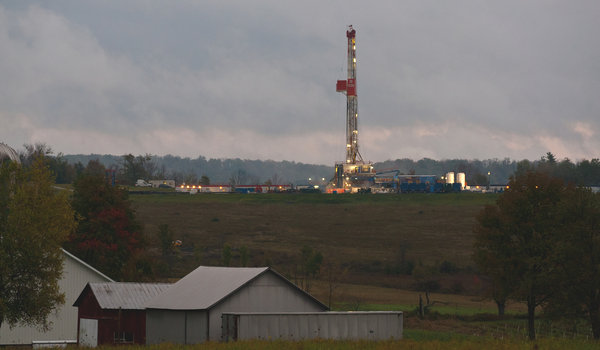WASHINGTON — Oil and gas companies will have to capture toxic and climate-altering gases from wells, storage sites and pipelines under new air quality standards issued on Wednesday by the Environmental Protection Agency.
U.S.
Caps Emissions in Drilling for Fuel

New federal air pollution standards are the first covering hydraulic fracturing, or fracking, in places like Susquehanna County, Pa.
By JOHN M. BRODER
Published: April 18, 2012
The rule is the first federal effort to address serious air pollution associated with the natural gas drilling process known as hydraulic fracturing, or fracking, which releases toxic and cancer-causing chemicals like benzene and hexane, as well as methane, a powerful greenhouse gas.
The standards were proposed last summer in response to complaints from citizens and environmental groups that gases escaping from the 13,000 wells drilled each year by fracking were causing health problems and widespread air pollution.
Industry groups said meeting the proposed standards would cost hundreds of millions of dollars and slow the boom in domestic natural gas production. The original proposal was significantly revised, giving industry more than two years to comply and lowering the cost.
“Because these regulations rely on technologies and practices that are already in use by some companies and required by some states, they are practical, flexible, affordable and achievable,” Gina McCarthy, head of the E.P.A.’s office of air and radiation, said in a conference call. “Natural gas is key to our clean energy future.”
She said the new rule would reduce emissions of volatile organic compounds by 190,000 to 290,000 tons per year and toxic air pollutants by 12,000 to 20,000 tons a year.
The agency said that the industry could meet the standards by deploying existing technology, and that nearly half the wells drilled using hydraulic fracturing already had the gas capture equipment, known as “green completions.”
The agency said that once the rule was fully effective, in January 2015, the industry would save $11 million to $19 million a year because drillers would be able to capture and sell the methane that is now burned off, or flared.
Methane is a potent heat-trapping gas, 20 times more powerful in its effect on the atmosphere than carbon dioxide. The E.P.A. estimates that capturing methane from thousands of new wells will reduce greenhouse gas emissions by the equivalent of 28 million to 44 million tons a year, making the rule one of the federal government’s largest measures to mitigate climate change.
The American Petroleum Institute, which had lobbied to weaken the proposed rule, said the revised standards issued Wednesday were an improvement over the original proposal. Howard Feldman, the institute’s director of regulatory and scientific affairs, said the industry had already adopted many of the requirements of the new rule and welcomed the delay in its effective date.
“The industry has led efforts to reduce emissions by developing new technologies that were adopted in the rule,” Mr. Feldman said. “E.P.A. has made some improvement in the rules that allow our companies to continue reducing emissions while producing the oil and natural gas our country needs.”
Other industry groups were less generous. The Western Energy Alliance, a group of independent oil and gas companies, said the new rule’s costs far outweighed its benefits and accused the E.P.A. of using the Clean Air Act illegally to deal with global warming.
Kathleen Sgamma, the group’s vice president for government affairs, also asserted that the rules were not flexible enough “to account for new exploratory areas where infrastructure does not yet exist.”
“Small businesses disproportionately operate in such conditions, and this rule could make exploring in new areas cost-prohibitive,” she said.
Environmental advocacy groups said the new rule was a step forward for clean air. The American Lung Association said that the reduction of a variety of emissions, including sulfur dioxide, nitrogen oxide and volatile organic compounds, would improve the health of people living downwind from oil and gas operations.
Ann Brewster Weeks, senior counsel for the Clean Air Task Force, said reductions in emissions that contribute to smog and global warming were good news but objected to the E.P.A.’s concessions on the timetable.
“Over the past few months, lobbyists for the gas industry have pushed to carve large exemptions out of the rule with arguments about the cost of the rules and asserted difficulty of complying,” she said. “These arguments are false, as we’ve made clear.”
“Regrettably, E.P.A. gave in to these claims in a few crucial ways,” she added. “Most significantly, they delayed the most important requirement — to clean up air pollution from fracked wells — for two and a half years.”